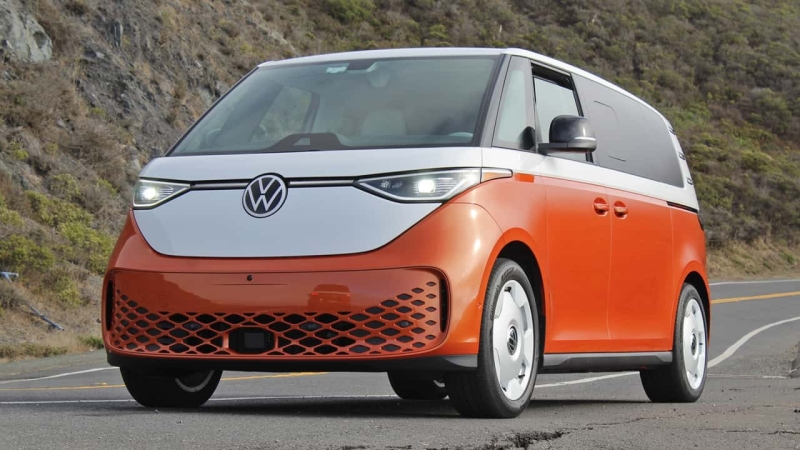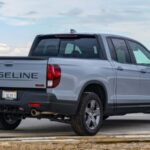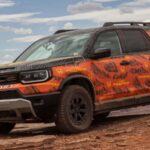Volkswagen made an extremely charming van in a sea of boring three-rows. But old-school allure can take it only so far.
Peter Holderith / Motor1
The Volkswagen ID.Buzz isn’t particularly efficient, it isn’t particularly cheap, and some parts of its interior are utterly infuriating to use. But I liked it—and so did everyone else who laid eyes on it. Without a doubt, it is the most charming three-row, seven-passenger vehicle you can buy right now. It definitely left me smiling.
But after driving it around San Francisco for a few hours, enough time to really think about its issues, I wondered how long that grin might last. Can buyers put up with this vehicle’s tradeoffs for months? Years?
| Quick Specs | 2024 Volkswagen ID.Buzz 1st Edition |
| Motor | Single Rear Synchronous Permanent Magnet |
| Output | 282 Horsepower / 406 Pound-Feet |
| Range | 234 Miles |
| Cargo Capacity | 145.5 cubic feet |
| Base Price / As Tested | $61,545 / $67,045 |
The ID.Buzz is the iconic Volkswagen Bus reborn as an electric vehicle. It’s effectively a three-row minivan underpinned by much of the same technology used in the ID.4. It has a 91.0-kilowatt-hour battery pack and a single rear permanent magnet motor, which unfortunately translates to mediocre range (just 234 miles), relatively slow charging (10-80% in roughly half an hour), and poor efficiency in terms of miles per kilowatt-hour. AWD models get an additional induction motor on the front axle which increases power to 335 hp and only reduces the range to 231 miles.
The problem with having a common platform for all your EVs, though, is that that platform might suck. In this case, Volkswagen’s isn’t very good—even by the standards of a huge legacy automaker. GM’s not-so-exceptional electric platform manages to get around 3 miles per kWh (in cars that aren’t the gargantuan Hummer EV). Hyundai/Kia’s platform is even better, and VW’s domestic competition from Munich is also superior to anything out of Wolfsburg. The ID Buzz is rated at just 2.6 miles/kWh.
This new Bus is therefore a pretty corporate car, which is a problem for a VW Bus to have. The iconic vehicle is nothing without its image. Thankfully, that’s where the ID.Buzz shines. The retro design works mostly thanks to its wonderful exterior colorways: eight of the 11 available are two-tone. Colors like Energetic Orange, Mahi Green, and Cabana Blue are available with a Candy White roof.
The interior is spartan, but it’s a sunny, airy, and unique place to sit. There’s lots of room, just like the original bus, and lots of charm, just like the original. And you get some modern technology in the form of SCREENS. The driver gets a little 5.3-inch instrument cluster (about the size of a smartphone) and a 12.9-inch infotainment display. To my taste, the instrument cluster was too small and too difficult to see.
Although 335 hp isn’t much for a car weighing 6,197 pounds in all-wheel-drive trim, the ID.Buzz doesn’t feel slow. It actually accelerates pretty quickly. It’s not a corner carver, either, with the steering giving the driver very little information about what the front end is up to. This, combined with the hefty curb weight and soft suspension, translates to a car that should not be driven in anger.
But hey, it’s a Minivan, so not being the most dynamic vehicle on the road is perfectly okay. It does other minivan things well, like having a reasonably silent cabin, even at highway speeds, and tons of passenger space—up to 145.5 cubic feet.
Like I said, though, there are problems. Using the switchgear in the ID.Buzz is an absolute hassle. The window switches are so bad that Volkswagen has already pledged to replace them in the ID.4 (two switches to control four windows: a great idea). I hope that promise also applies to this car. The touchscreen infotainment is likewise poorly organized, and difficult to use, and so many things that should be physical controls are not.
Somehow, though, the charm of the ID.Buzz convinced me it could’ve all somehow been worse. People with timeshares, paid-off mortgages, and a love for rum-raisin ice cream couldn’t help but smile as I drove along. They approached me when I parked. They liked the color, and the fact it was electric, and they didn’t even think its $61,545 starting price was too much.
“Only 230 miles on a charge? Well, I’m not going that far these days anyway.”
Saying VW has AARP members on lock isn’t exactly high praise, but it’s not necessarily an indictment, either—Boomers have plenty of disposable income. While so many cars struggle to find an audience, the ID.Buzz is able to woo customers simply with its retro charm. I’m just not sure how attached that audience will be when their lease is up and there are better EVs out there.
Charisma will only take you so far. Harken back to other throwback cars like the PT Cruiser. It was a lovable icon that people started calling the PT Loser while it was still in production. On the other hand, there’s the Ford Bronco. It’s retro-styled, sure, but it has real utility. It’s competitive within its segment.
While the three-row EV market isn’t all that populous yet, that means there’s enough room for the ID.Buzz. At least right now. Despite its poor range, frustrating controls, and other noteworthy pain points, it has a ton of space, USB power for every kid, and it charms the heck out of the passersby. It’s an endearing EV in a sea of bland, uncharismatic cars that would be better off as grid storage.
The ID.Buzz may look like a toaster, sure, but you could never accuse it of being an appliance.
Gallery: 2025 Volkswagen ID.Buzz First Drive Review
Peter Holderith / Motor1
Competitors
- Kia EV9
- Volvo EX90
Get the best news, reviews, columns, and more delivered straight to your inbox, daily. Sign up For more information, read our
Privacy Policy and Terms of Use.
2025 Volkswagen ID.Buzz 1st Edition
Motor Single Rear Synchronous Permanent Magnet
Battery 91.0 Kilowatt-Hour Lithium-Ion
Output 282 Horsepower / 406 Pound-Feet
Drive Type Rear-Wheel Drive
Speed 0-60 MPH 8.0 Seconds (est.)
EV Range 234 Miles
Charge Time 10-80% In ~30 Minutes
Seating Capacity 7
Cargo Volume 145.5 Cubic Feet
Base Price $61,545
As-Tested Price $67,045



